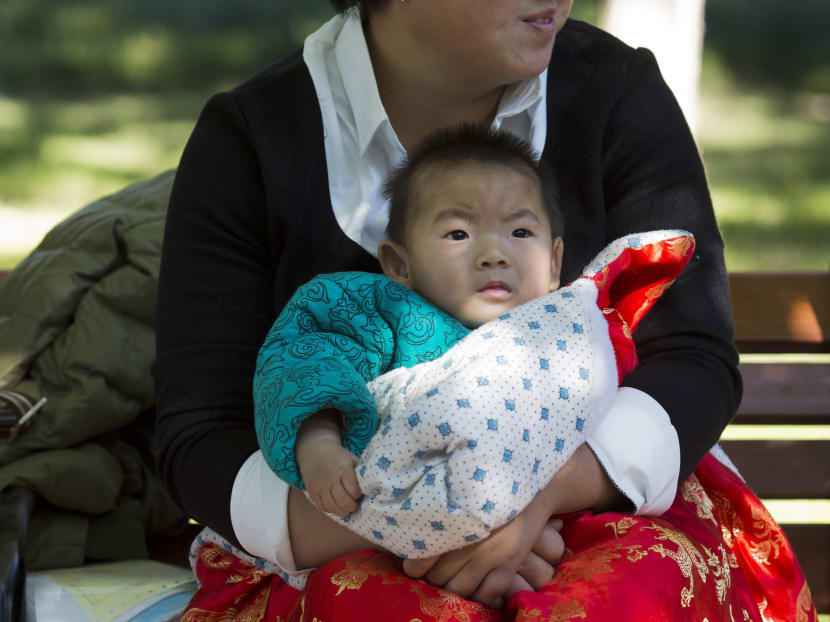Now allowed to have a second child, older Chinese turn to science
BEIJING — China’s decision to allow all married couples to have two children is driving a surge in demand for fertility treatments among older women, putting heavy pressure on clinics and breaking down past sensitivities, and even shame, about the issue.

A child is wrapped up against the cold at a park in Beijing, China, Friday, Oct. 30, 2015. AP file photo
BEIJING — China’s decision to allow all married couples to have two children is driving a surge in demand for fertility treatments among older women, putting heavy pressure on clinics and breaking down past sensitivities, and even shame, about the issue.
The rise in in vitro fertilisation (IVF) points to the deferred dreams of many parents who long wanted a second child, but were prevented by a strict population control policy in place for more than 30 years.
That, in turn, is shifting prevailing attitudes in China regarding fertility treatments — formerly a matter of such sensitivity that couples were reluctant to tell even their parents or other family members that they were having trouble conceiving.
“More and more women are coming to ask to have their second child,” said Dr Liu Jiaen, who runs a private hospital in Beijing treating infertility through IVF, in which an egg and sperm are combined in a laboratory dish and the resulting embryo transferred to a woman’s uterus.
Dr Liu estimated that the number of women coming to him for IVF have risen by 20 per cent since the relaxation of the policy, which came into effect at the start of the year. Before, the average age of his patients was about 35. Now, most of them are older than 40 and some of the women are fast approaching 50, he said.
“They have a very low chance to get pregnant so they are in a hurry. They really want to have a child as soon as possible,” said Dr Liu.
Ms Chen Yun is 39 and was in the hospital waiting to have the procedure for the first time. She and her husband have a seven-year-old son and their families are encouraging them to have a second child.
“We are coming to the end of our child-bearing years. It may be difficult for me to get pregnant naturally because my husband’s sperm may have a problem, so we want to resolve this problem through IVF,” she said.
Ms Chen said she hoped having a brother or sister would make their son happier, more responsible and less self-absorbed.
Over the past two decades, IVF technology has developed rapidly in China, where about 10 per cent of couples are estimated to need the procedure to conceive. In 2014, 700,000 women had IVF treatments, according to the health commission’s women’s and children’s department, which said in a statement that demand for all types of fertility treatment had risen following the policy relaxation, including the use of traditional Chinese medicine.
Previously, China limited most urban couples to one child and rural couples to two if their first was a girl. There were exceptions for ethnic minorities, and city dwellers could break the policy if they were willing to pay a fee calculated at several times a household’s annual income.
While the authorities credit the policy introduced in 1979 with preventing 400 million extra births, many demographers argue the fertility rate would have fallen anyway as China’s economy developed and education levels rose.
Intended to curb a surging population, the policy has been blamed for skewing China’s demographics by reducing the size of the future workforce at a time when children and society face more demands from the growing ranks of elderly. It also inflated the ratio of boys to girls as female foetuses were selectively aborted.
In November, the National Health and Family Planning Commission said 90 million women would become eligible to have a second child following the policy change. The authorities expect that will add 30 million people to the country’s labour force by 2050.
Calls have also gone out for a loosening of China’s adoption law, which currently states that only couples with no children can adopt, while also allowing couples with one child to adopt a disabled child or an orphan.
The Ministry of Civil Affairs did not respond to a question on whether the law would be changed, and it could not say whether the number of couples seeking adoption had risen since the policy change. It said there were 109,000 children available for adoption in the custody of governmental institutions, 90 per cent of whom were disabled and 60 per cent severely disabled.
Mr Zhang Mingsuo, a professor at Zhengzhou’s University’s School of Public Administration, said few Chinese couples were willing to adopt disabled children “because they worry about the possible heavy medical expense.” AP





